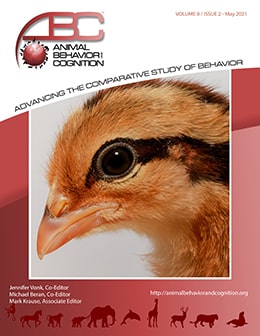Vol 8, Issue 2, May 2021
New Caledonian Crows and Hidden Causal Agents Revisited
Citation
O’Neill, L., Linder, G., van Buuren, M., & von Bayern, A.M.P. (2021). New Caledonian crows and hidden causal agents revisited. Animal Behavior and Cognition, 8(2), 166-189. https://doi.org/10.26451/abc.08.02.06.2021
Abstract
A previous experiment suggested that New Caledonian crows (Corvus moneduloides; henceforth NCCs) can reason about hidden causal agents (Taylor et al., 2012). In that study, subjects showed greater vigilance towards an area from which they had previously witnessed a threatening “stick attack” if a hidden causal agent (a human) could still be present in that area compared to when a human person had visibly left. Interpretations of these results were challenged in two commentaries (Boogert et al., 2013; Dymond et al., 2013). We aimed to replicate this experiment with a different group of NCCs (N = 14) whilst also adding three additional control groups that addressed the issues raised in the two commentaries. These four experimental groups included a direct replication (n = 4), a counter balance of the events of that replication (n = 4), a control group to see if alternative associative cues would create the same effect (n = 3) and finally, a counterbalanced group of these alternative associative cues (n = 3). The direct replication group did not replicate the effect of Taylor et al. (2012). The fact that we did not replicate the effect meant that further interpretation of our other control groups proved difficult. The low sample size of our replication group meant we could not be sure if we did not replicate the effect due to low power or due to actual differences. Our findings neither support nor refute whether NCCs reason about hidden causal agents.
Keywords
Causal agents, Causal cognition, New Caledonian crows, Corvids
